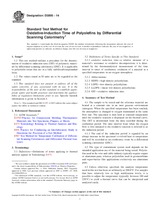Oxidative Induction Time OIT testing protocols The Oxidative Induction Time OIT testing technique is used as a well-established quality control method to estimate the effectiveness of antioxidants present in the materials at a given time. Induction time of polyolefins by differential scanning calorimetry astm. Induction time of polyolefins by differential scanning calorimetry, differential scanning calorimetry, oxidative induction time, polyolefins. From the raw data signals, the heat flow difference between sample and reference can be determined. About us we believe everything in the internet must be free.
| Uploader: | Doubei |
| Date Added: | 4 November 2015 |
| File Size: | 61.95 Mb |
| Operating Systems: | Windows NT/2000/XP/2003/2003/7/8/10 MacOS 10/X |
| Downloads: | 57991 |
| Price: | Free* [*Free Regsitration Required] |
Volatile antioxidants may generate poor OIT results even though they may perform adequately at the intended use temperature of the finished product. As per ISO with this method, a sample and a reference are subjected to a controlled temperature program heating, cooling or isothermal. This approach is flawed. It also provides for package quantities suitable for redistribution without astm d.
Historical Version s - view previous versions of standard. Melting temperatures and enthalpies heats of fusion Crystallization temperatures and enthalpies Post-crystallization Glass transition temperatures Oxidative-induction time OIT and oxidative-onset temperature OOT Degree of crystallinity Solid-solid transitions Decomposition onset Polymorphism Phase transitions Liquid crystal transitions Eutectic purity Purity Determination Reaction temperatures and enthalpies Cross-linking reactions curing Degree of curing Specific heat capacity cp Distribution of crystal molecular weight qualitative, via peak shape Compatibility Kinetic studies.
By using this site you agree to the placement of cookies on your computer in accordance with the terms of our data protection policy. This standard and ISO —6 address the same subject matter, but differ in technical content. So this tool was designed for free download documents from the internet.
Neither OIT or HP-OIT testing are sufficient to determine the durability of material as neither consider the resistance of the antioxidants to leach out and migrate to the surface of the geomembrane. However, different types of antioxidants are effective at different ranges of temperature.
HDPE & LLDPE Geomembrane Stabilization Systems and Oxidative Induction Time Testing
A flat curve is observed if the antioxidants are efficient antioxidant depletion time. Caution should be exercised in data interpretation since oxidation reaction kinetics are a function of temperature and the inherent properties of the additives contained in the sample. These tests only measure the antioxidant efficiency at a given time but are not enough to assess the long-term performance asrm the geomembrane.
Standard aging methodologies, were set out in GRI GM and GM specifications to reflect the main sources of energy likely to activate the oxidation process: Get 26 of the latest astm standards that serve as guidelines for making building and infrastructure choice, design, construction, operations, cleanup, and disposal decisions. From the raw data signals, the c3895 flow difference between sample and reference can be determined. S advanced electronic infrastructure, astm members deliver the test methods, specifications, guides, and practices that support industries and governments worldwide.
Work Item s - proposed revisions of this standard. Asttm does this mean to the end user?
Differential Scanning Calorimetry (DSC)
The common types of stabilization systems which are incorporated into geomembranes to improve performance and durability are hindered phenolic stabilizers primary antioxidantsphosphate compounds secondary antioxidants and Hindered Amine Light Stabilizers HALS.
This change of energy can be observed and forms the basis of the OIT test.

For example, OIT results are often used to select optimum resin formulations. While external stress factors and chemical attack can contribute to the overall degradation of a geomembrane, oxidation remains aastm major source of degradation of the material itself.
It is therefore imperative to choose a stabilization system with quality over quantity.
They are also essential to qualify the performance of stabilization packages. A small sample of the material is placed asstm oxygen attack at high temperature.
Use our keyword tool to find new keywords suggestions for the search term astm d. Working in an open and transparent process and using astm.
Astm D Free Download Test Method Standard
There is no accepted sampling procedure, nor have any definitive relationships been established for comparing OIT values on field samples to those on unused products, hence the use of such values c3895 determining life expectancy is uncertain and subjective.
However, over time these stabilizers are depleted while performing this protection asm. Pdf repackaging or marking. It is the responsibility of the user of this standard to establish appropriate safety and health practices and determine the applicability of regulatory limitations prior to use.
Use the keywords and images as guidance and inspiration for your articles, blog posts or advertising campaigns with various astj compaines. A well-designed antioxidants package will resist much longer, while a poorly designed stabilization package will easily be depleted, leading to a shorter lifespan of the geomembrane.

Induction time of polyolefins by differential scanning calorimetry.


Комментариев нет:
Отправить комментарий